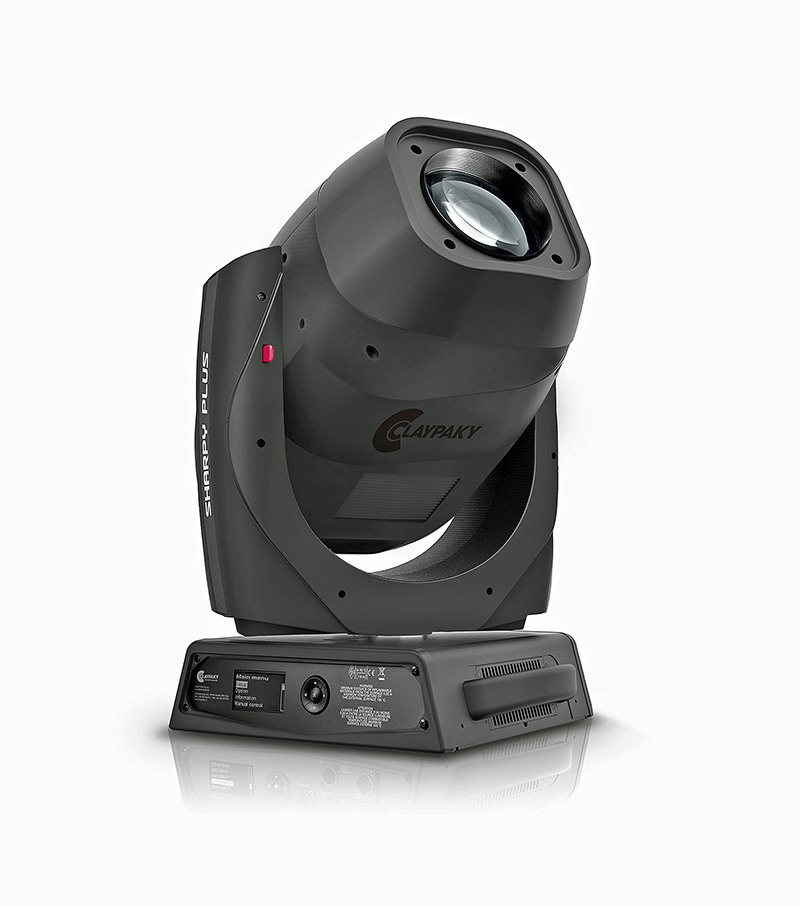
Most people would agree that any product with a “2.0” or a “Plus” label on it is an upgrade, a fix to customer complaints, maybe an implementation of ideas invented post-release. More often than not, life testing and product usage reveal small improvements that need to be made to extend the life of a product. This is a product life cycle. But there are exceptions to every rule.
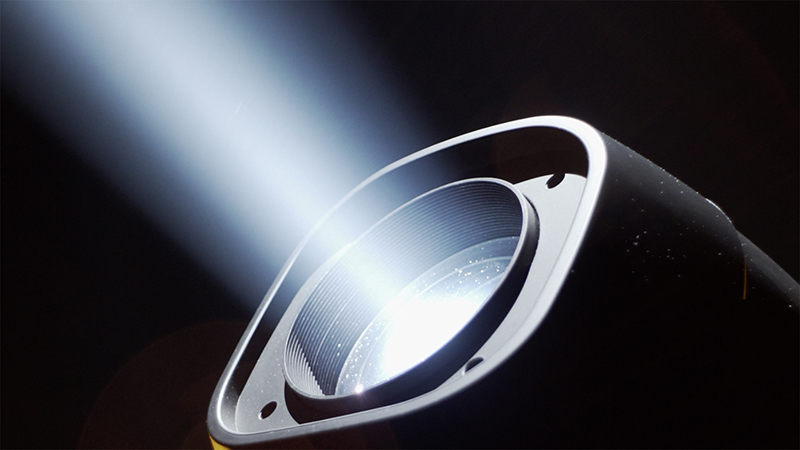
A Completely New Fixture
Claypaky’s Sharpy Plus isn’t a “part two” fixture. It’s not an improvement, it’s a key player, a sharer of the load of design requirements for today’s work. Sharpy Plus is a completely new fixture built from the industry’s demand for a high-quality hybrid beam/spot, and their excellence with the original Sharpy product that became a world class icon of design. A more powerful light source at 330W (the original Sharpy was a 190W, measuring about 60,000 lux at 20 meters), a drastically excellent zoom range, and smoothness across all aspects of construction, movements, and appearance.
As a side note, if you saw the 2019 Eurovision Song Contest finals, which took place in Tel Aviv in May, lighting designers Ronen Najar and Dakar Azulay used 152 Sharpy Plus in their design, which included 406 Claypaky products in all.
“The key focus of Sharpy Plus is that we wanted to create a powerful tool that was useful and cost-effective for everyone,” says George Masek, strategic marketing manager for Claypaky. “We know there’s a need for a fixture that can do both what a Sharpy can do, and also more of what a dedicated spot-only fixture can do. The goal is to offer a light for the high-volume production companies flipping hundreds of fixtures a day, and also the smaller shops that need a luminaire that can operate as a multitasker and be great at everything they need it to do.” Sharpy Plus has an MSRP of $7,100, a price point that works for everyone.
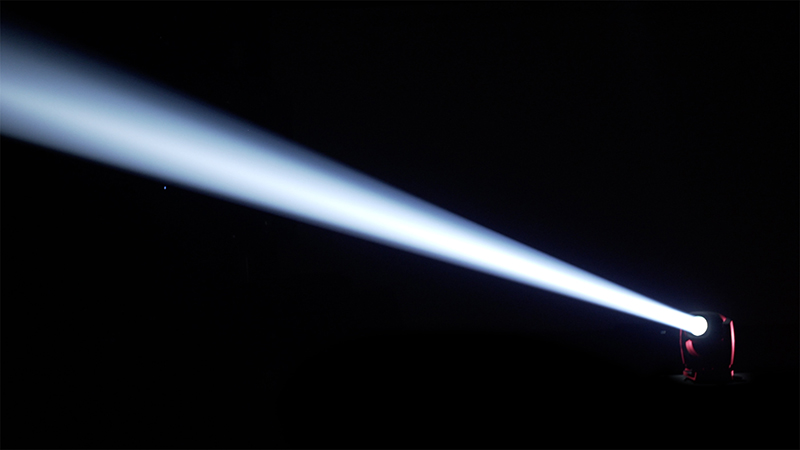
Beam Mode
You cannot help being a bit awe-struck at the power of the Sharpy Plus when it is playing “Sharpy” mode, what Claypaky calls Beam Mode; the fixture has two modes, Beam Mode and Spot Mode. (We’ll pick up on Spot Mode here shortly.) Sharpy Plus in Beam Mode is very much like a Sharpy that had a Beast mode — that classic, crisp beam Sharpy look that we all know and have worked into everything a million times, except with a Joe Louis punch. The point of beam convergence, one of the most attractive parts of the original Sharpy, looks like it has its own presence, very reminiscent of the beam projectors of yore, but refined. The 330W X8 HRI Sirius from Osram powers the light, and the optics of the Sharpy with almost twice as much gas turns that beam into a pure plasma cannon, and we were looking at the unit at about 100 feet. The stamped gobos, the color gobos, the prisms — everything on the output side of the Sharpy Plus in Beam Mode — is near what you’re used to seeing, except for more energy, more presence.
Spot Mode
At the optimal point in the Sharpy Plus optical system, there is a disc-shaped collimating lens that rolls into and out of the beam and completely transforms the shape and stature of the Sharpy beam. That beam projector look that became so famous, into a full-fledged spot with crisp edges, focusable gobos and effects, and a flat field. Just to reiterate that, Sharpy Plus can turn from Beast Sharpy into a flat, even field spot and can behave like any other 330W spot fixture.

The Zoom
Perhaps one of the most important aspects of Sharpy Plus is that it has a zoom range, and that alone has given you a plethora (Jefe, what is a plethora?) of new looks, because that Beam mode look zoomed out to 36 degrees and back is a monster look. Sharpy Plus’ zoom range is three to 36 degrees, with 3 degrees being its tightest angle. There are of course reducers in the gobo wheel as well, for those times when you need to turn your Sharpy Plus into something reminiscent of a laser beam (down to 0.5 degrees). In Spot Mode, Sharpy Plus zooms smoothly along its rails, maintains a crisp focus, and frankly it’s just exciting to have the punch of a Sharpy with an extreme enhancement to output that can also be a spot. Perhaps we are redefining what “hybrid” means in our market, because Sharpy Plus isn’t good at doing three modes (Spot, Beam, Wash), it is excellent at doing two (Spot and Beam).
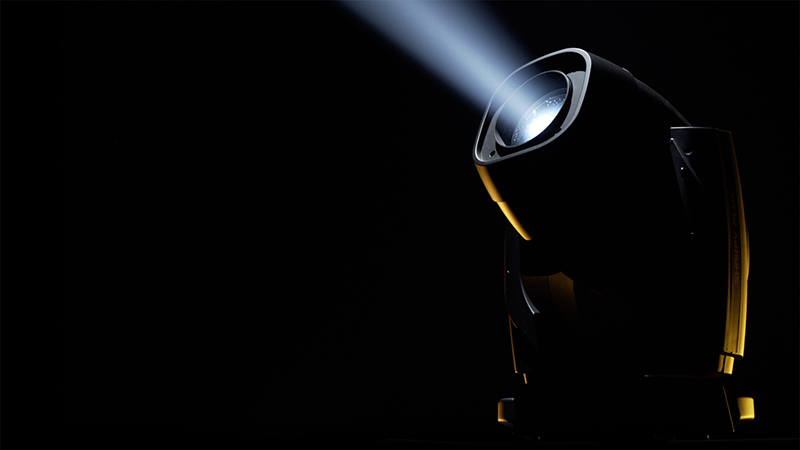
The Beam Path
Most obvious in the Sharpy Plus is the homogenizing lens that takes us from Spot to Beam instantaneously. This little device literally makes magic in front of your eyes. You can read about it all day long, but you must see this happen.
In addition to an 18-gobo fixed gobo wheel that includes five reducers (down to a half of one degree spread), there is an eight-position rotating wheel with eight interchangeable glass gobos. Sharpy Plus makes great use of these gobos with a four-facet and eight-facet prism, each on their own dedicated channel.
A linear frost filter gives a soft edge on both Beam and Spot modes and allows Sharpy Plus to do some wash tasking as well. Also of note, effective in both Beam and Spot is the Dynamic Animation Disc, allowing you to animate any of your looks in the Sharpy Plus, insertable and removable via its dedicated control. Add to this a smooth dimmer and a strobe/stop for those very abrupt blackouts and strobing effects.
Color System
Sharpy Plus has a unique color system of CMY mixing and dedicated color chips, integrated into three wheels. Color mixing is not affected by this design; in fact, having the ability to mix in colors to a fixed color gives you control over making unique hues. Two CTO color chips give you a Kelvin reduction of 3200° and 2500°, respectively. My only complaint with the color mixing system was the mixed red — not a true red, but adjustable enough.
Fixture Handling
Weighing in at around 50 pounds (50.7, to be precise), Sharpy Plus is easy to maneuver, one-person or two, and construction is solid. The optical devices and zoom are in their own bulkheads for easier maintenance on the fixture. Akin to that, the Sharpy Plus also solves a longtime annoyance of mine with any fixture and captive screws holding the covers on — the securing hardware takes a quarter of a turn and pops out, spring loaded to let you know that your hardware is free and the cover can be removed. Along that line, the pan and tilt locks on the unit make it perfectly clear whether the fixture is locked (red) or unlocked.
Sharpy Plus operates on just one profile needing 31 DMX channels. Getting data to the fixture can be done via the onboard DMX512 in and thru, or the Ethernet in and thru on the faceplate. Copper DMX, RDM, Art-Net, and the Claypaky webserver access can be used to control and manipulate fixtures.
Pound for pound, Sharpy Plus is worth every nickel of its already appealing price tag. A brighter beam in its Beam mode and the addition of a completely usable Spot mode make the Sharpy Plus something everyone should see. I expect these to be very popular at upcoming trade shows.
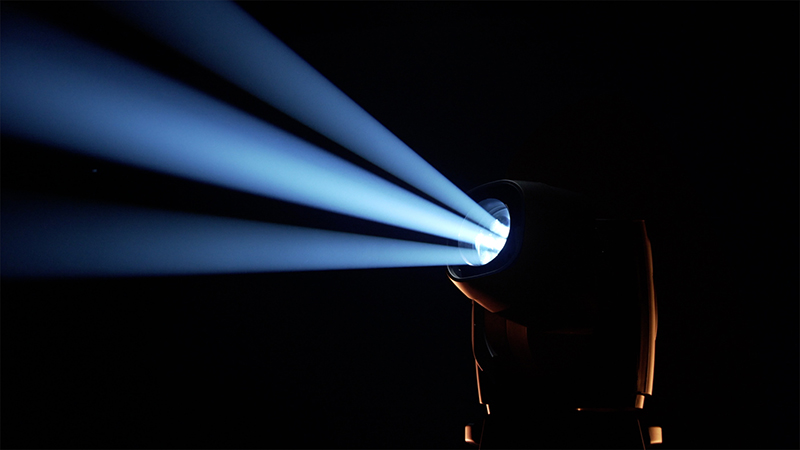
At a Glance:
Beam Plus Spot Plus More
Sharpy Plus is a true two-for-one beam/spot fixture with almost twice the lamp power of the Sharpy. Sold at an affordable and reasonable price, Sharpy Plus provides a super-bright Beam Mode very reminiscent of the original Sharpy look, but with more power; and a Spot Mode that turns the Sharpy Plus into a full-fledged genuine spot. Both modes benefit from the Sharpy Plus’ 3-36° zoom range. Plus a unique color system.
PROS
Zoom range, two distinct modes, Spot and Beam, and the look of the original Sharpy beam with considerably more power.
CONS
Red isn’t quite true, but can be worked around
FEATURES
- Rotating gobo wheel, 8 interchangeable glass gobos
- Static gobo wheel, 18 fixed gobos, 6 of which are beam reducers (down to 0.5°)
- 4-facet and 8-facet prisms
- Dynamic animation disc
- Linear soft-edge frost
- Fast movements
- CMY mixing, plus 15 static colors on 3 wheels
- 2 CTO filters (2500°K and 3200°K)
- 31 DMX channels, one profile
- Switching power supply, PowerCON True1 port in/thru
- RDM, Art-Net, webserver protocols
- DMX512 and Ethernet ports for control
STATS
- Lamp Source: 330W Osram Sirius X8 HRI
- Modes: Beam, Spot
- Output: 300,000 lux @10m (Beam Mode)
- Size: 25” x 15.9” x 14.8” (HxWxD)
- Weight: 50.7 lbs.
- MSRP: $7,100
Manufacturer: Claypaky
More info: www.claypaky.it


